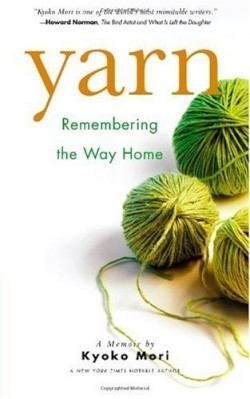Yarn
Remembering the Way Home
It may have been Emily Dickenson who first suggested the fullness of absence, but in her appealing memoir, Yarn: Remembering the Way Home, Kyoko Mori updates the concept. “In knitting, the holes are constructedÂ…” she writes. “You build what is usually taken away. Loss can expand as well as constrict us: an absence is also an opening.”
She ought to know.
In 1970s’ Japan, where her story begins, mastering domestic arts is paramount for middle class girls anticipating future arranged marriages. But Mori’s plans are fueled by a once spunky mother who married for love and nurtures her daughter’s artistic intellect. Mori is as uninterested in being properly finished as in completing the mittens she’s assigned in knitting class.
When her mother’s suicide brings disgrace, Mori’s neglectful, apathetic father, insecure stepmother, and indifferent extended family convince her she’s now unmarriageable. College scholarships let her flee to the American Midwest, where she settles, marries, earns a Ph.D., and burrows under snow, knitting, and work to stave off further loss. Later, it isn’t so much a love of knitting that saves the author, but a relationship with yarn, pattern, and the act of crafting comfort and beauty, reconnecting her to what appears left behind.
Yarn lore, knitting history, how patterns developed, even the process of raising Angora rabbits for wool provide vividly detailed narrative scaffolding. But Mori is careful not to pull the metaphorical threads too tightly.
Writing and knitting nourish and define, but also isolate, the author. She publishes critically admired books but hides under baggy knitted pullovers, an unchallenging teaching job, a companionable but hollow marriage, and the unhealed scars of shame, guilt, and confusion from her mother’s suicide.
Eventually, the author finds her way to new communities of knitters and weavers, and to the podium in the lecture halls of Harvard, leaving behind land, husband, and tenure. Stitch by stitch, she works her way toward an inner home, integrating the many-hued strands of grief, cultural identity, and family estrangement. Finally, she wraps herself in acceptance of her own ambition, independence, and need for solitude, with a growing recognition of what the empty spaces mean.
In the end, knitting itself seems less important and often not as compelling as unraveling the still-unfinished garment: looking back, while contemplating moving forward, to trace each strand’s skewed origin and deciding whether, and how much, still belongs.
Disclosure: This article is not an endorsement, but a review. The publisher of this book provided free copies of the book to have their book reviewed by a professional reviewer. No fee was paid by the publisher for this review. Foreword Reviews only recommends books that we love. Foreword Magazine, Inc. is disclosing this in accordance with the Federal Trade Commission’s 16 CFR, Part 255.

